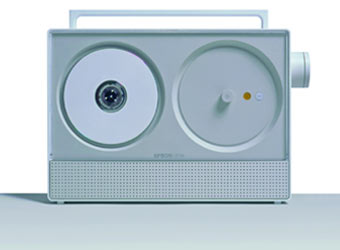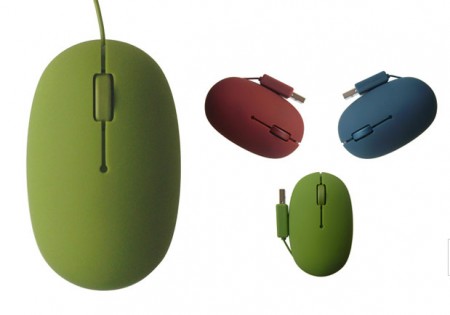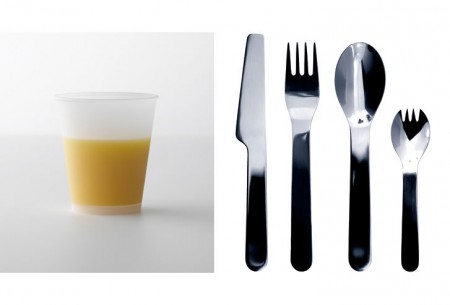Design Studio Review: Sam Hecht
Theses:
• I recently learned about the word makoto , which means “the true nature of things” in Japanese. Now I know what it's called in one word.
• I do not really like Italian design. It is saturated, filled with what I call Authorship.
= I like it when the author is not enough, but the essence of the thing, the nature of the material and the function are revealed more.
There are very few people who have the ability to manifest the nature of a thing, “makoto”. One such is Sam Hecht .

')
After graduating from RCA - the Royal College of Art - he worked in the studio of David Chepperfield , who became interested in the concept of the environment. And of course, through this came the realization that each thing is a part of something whole, a part of one system. After some time, Hekta fate brought Japanese Naoto Fukasawa and he got into the staff of IDEO , where he designed items for companies such as Epson, Panasonic, National (Matsushita), Prada, Muji and other giants. In this you can see the providence of fate, because at the moment Hekt is in great demand in Japan, his aesthetic views have come to court.

Sam Hecht's latest development for Panasonic. No comments!
Today Hekta has its own small studio, which has 5 people (and this is after the giant IDEO with 4 offices around the world!). I think that after working with the Japanese company MUJI, he became imbued with the idea of a “label-free thing” (this is the name for Muji, which I have already promised to tell about in more detail) and therefore called my office Industrial Facility - Production Services .


Second Telephone for Muji. Manipulator mouse;) Mouse Trap for Lexon.
If you run through the list of items on the website of his studio, you can see that most of the projects done for Lexon, the French electronics giant, unfortunately, are not very well known to us. Lexon, like LG in Korea or Sony in Japan, is not only a manufacturer of technology, but also an institute for the development of new technologies, research in the field of design, interfaces and the environment. Thus, in the study of the relationship of a person with a thing appeared Once Watch and Twice Clock, as well as the Gum series (“chewing gum”), in which a block of Wrigley's Spearmint type plates was taken as a model - a familiar form that can be easily identified in a bag or in the dark.

Sound Gum - an MP3 player that can be worn as a decoration, a Data Gum flash drive and a USB light for Claudia and attracting Light Gum mosquitoes
My love for Hekt is at first sight. When I saw his work with IDEO, in the community and the support of Fukasawa (oh yeah, this character is next in line for Muji) then he just lost his head - what is considered in our institutions to be pampering and postmodern igrulkami, it is studied in serious institutions like social issues, taking into account psychology, biology and physiology. And, most importantly, it is much closer to me than the sovok scholastic approach of "learn from this to this."
Hekt draws attention to how a person lives with a thing, which habits on the one hand, and trends on the other, surround the user. Yesterday we used Post-it! Leaves, and today Outlook sends us an email with this reminder. Or maybe it would be logical to take the remote control, phone, watch, and in general any device of frequent use - take and fill it with completely soft rubber, to make it easier to wash, so that when falling it doesn’t break off, and having dropped into the soup, you only have to groan about the spattered trousers? For Hekta, this is logical, therefore he creates a series of Soft objects, in a soft translucent shell of a characteristic digital design.

Post-It for Seiko receive SMS messages (and in the illustration they recite - “I'M ANALOG!”) And the Soft Remote remote control for ElekSen
Or here's another: paper cups are known for their cheapness in production and ... in sensations. Coffee and beer drink from paper cups somehow full. But the paper has nice tactile properties. And the glass has a pleasant transparency, especially if it is opaque. For the Japanese company Takeo, he comes up with a cheap paper Haptic Cup, which is translucent and very pleasant to the touch. Hares are dying not in pairs, but in colonies.
And if a trip from expensive material to a cheap one is possible, then the return journey will be even more interesting - here comes the irony! Steel flatware Flatware (literally - "Flat appliances") for Taylor's Eye Witness are based on the design of plastic utensils - flat and "stackable."

It’s time to say that Sam Hecht’s studio designs furniture and fixtures. In this he is helped by his comrade-in-arms and concurrently the architect, Kim Colin.
The newly launched British company Established and Sons in the production of designer furniture (the phenomenon is somewhat surprising - although the United Kingdom annually produces a mountain of designers, organizes an exhibition of 100% Design, and indeed in general ahead of the rest, but does not have any production of good designer furniture). Beam. The main idea of the appearance is to attach a beam of outgoing light to the lamp. Nice such a decision. I want to note that getting an order from E & S is very good, because it produces products in small editions, and Zaha Hadid, Future Systems, Barber Osgerbi, Michael Young and other grandees are among the invited designers.

Also, experimenting with new materials for a long time, Hecht made the FlexLamp lamp for the Dutch company Droog Design . Its lampshade is molded of silicone, which can withstand temperatures up to 220 degrees Celsius, does not turn yellow, is soft and pleasant to the touch, and also gently diffuses light. Just a miracle, not a lamp (soon there will be no hares!). Then he repeated it for someone else under the name of 6 Light Years (apparently, he thought so much about whether to repeat or not). ;)
And lastly, I left something from which at one time lost my head: projects for Epson. I will not be wordy this time - things will say everything for themselves. A printer created under the impression of a pot of flowers (a white “bowl” or “pallet” is removed from the top, which is used as a tray for printed sheets), a basket-print printer called “Printing Friend” and ... drum roll - the DVD player that you could see at the very beginning. It can also be used as a projector. Unfortunately, I did not find on-line the best photo of this player, so I’m adding a description with the words: if a disc is inserted into the first slot of the player, then the second one holds the remote control (removable, of course - therefore not shown in the illustration), the same round, as a disc and with a number of buttons not exceeding the interface on the game console joy pad.

In the end - a couple of quotes from an interview with the magazine MONITOR Unlimited (No. 26):
M: What was the hardest thing to design ?
SH: Probably the hardest thing at the moment is that chair. We have been working on projects for about a year now (for example, author's note) we have been developing a chair for Muji for the rest. I have never made chairs before - I approached this topic, but I didn’t work closely. It turned out very difficult, because the question arises about how to sit. Everything seems to have already been invented, so we have to think hard about the goals, the results and what we really can do.
M: What orders would you not undertake ?
CX: A standard set that includes weapons. We received an offer from a tobacco company and refused it. I'm also not sure that I would cooperate with individual manufacturers of chocolate ...
; R
UPD : first edition of Design Studio Review: GRO Design
• I recently learned about the word makoto , which means “the true nature of things” in Japanese. Now I know what it's called in one word.
• I do not really like Italian design. It is saturated, filled with what I call Authorship.
= I like it when the author is not enough, but the essence of the thing, the nature of the material and the function are revealed more.
There are very few people who have the ability to manifest the nature of a thing, “makoto”. One such is Sam Hecht .

')
After graduating from RCA - the Royal College of Art - he worked in the studio of David Chepperfield , who became interested in the concept of the environment. And of course, through this came the realization that each thing is a part of something whole, a part of one system. After some time, Hekta fate brought Japanese Naoto Fukasawa and he got into the staff of IDEO , where he designed items for companies such as Epson, Panasonic, National (Matsushita), Prada, Muji and other giants. In this you can see the providence of fate, because at the moment Hekt is in great demand in Japan, his aesthetic views have come to court.

Sam Hecht's latest development for Panasonic. No comments!
Today Hekta has its own small studio, which has 5 people (and this is after the giant IDEO with 4 offices around the world!). I think that after working with the Japanese company MUJI, he became imbued with the idea of a “label-free thing” (this is the name for Muji, which I have already promised to tell about in more detail) and therefore called my office Industrial Facility - Production Services .


Second Telephone for Muji. Manipulator mouse;) Mouse Trap for Lexon.
If you run through the list of items on the website of his studio, you can see that most of the projects done for Lexon, the French electronics giant, unfortunately, are not very well known to us. Lexon, like LG in Korea or Sony in Japan, is not only a manufacturer of technology, but also an institute for the development of new technologies, research in the field of design, interfaces and the environment. Thus, in the study of the relationship of a person with a thing appeared Once Watch and Twice Clock, as well as the Gum series (“chewing gum”), in which a block of Wrigley's Spearmint type plates was taken as a model - a familiar form that can be easily identified in a bag or in the dark.

Sound Gum - an MP3 player that can be worn as a decoration, a Data Gum flash drive and a USB light for Claudia and attracting Light Gum mosquitoes
My love for Hekt is at first sight. When I saw his work with IDEO, in the community and the support of Fukasawa (oh yeah, this character is next in line for Muji) then he just lost his head - what is considered in our institutions to be pampering and postmodern igrulkami, it is studied in serious institutions like social issues, taking into account psychology, biology and physiology. And, most importantly, it is much closer to me than the sovok scholastic approach of "learn from this to this."
Hekt draws attention to how a person lives with a thing, which habits on the one hand, and trends on the other, surround the user. Yesterday we used Post-it! Leaves, and today Outlook sends us an email with this reminder. Or maybe it would be logical to take the remote control, phone, watch, and in general any device of frequent use - take and fill it with completely soft rubber, to make it easier to wash, so that when falling it doesn’t break off, and having dropped into the soup, you only have to groan about the spattered trousers? For Hekta, this is logical, therefore he creates a series of Soft objects, in a soft translucent shell of a characteristic digital design.

Post-It for Seiko receive SMS messages (and in the illustration they recite - “I'M ANALOG!”) And the Soft Remote remote control for ElekSen
Or here's another: paper cups are known for their cheapness in production and ... in sensations. Coffee and beer drink from paper cups somehow full. But the paper has nice tactile properties. And the glass has a pleasant transparency, especially if it is opaque. For the Japanese company Takeo, he comes up with a cheap paper Haptic Cup, which is translucent and very pleasant to the touch. Hares are dying not in pairs, but in colonies.
And if a trip from expensive material to a cheap one is possible, then the return journey will be even more interesting - here comes the irony! Steel flatware Flatware (literally - "Flat appliances") for Taylor's Eye Witness are based on the design of plastic utensils - flat and "stackable."

It’s time to say that Sam Hecht’s studio designs furniture and fixtures. In this he is helped by his comrade-in-arms and concurrently the architect, Kim Colin.
The newly launched British company Established and Sons in the production of designer furniture (the phenomenon is somewhat surprising - although the United Kingdom annually produces a mountain of designers, organizes an exhibition of 100% Design, and indeed in general ahead of the rest, but does not have any production of good designer furniture). Beam. The main idea of the appearance is to attach a beam of outgoing light to the lamp. Nice such a decision. I want to note that getting an order from E & S is very good, because it produces products in small editions, and Zaha Hadid, Future Systems, Barber Osgerbi, Michael Young and other grandees are among the invited designers.

Also, experimenting with new materials for a long time, Hecht made the FlexLamp lamp for the Dutch company Droog Design . Its lampshade is molded of silicone, which can withstand temperatures up to 220 degrees Celsius, does not turn yellow, is soft and pleasant to the touch, and also gently diffuses light. Just a miracle, not a lamp (soon there will be no hares!). Then he repeated it for someone else under the name of 6 Light Years (apparently, he thought so much about whether to repeat or not). ;)
And lastly, I left something from which at one time lost my head: projects for Epson. I will not be wordy this time - things will say everything for themselves. A printer created under the impression of a pot of flowers (a white “bowl” or “pallet” is removed from the top, which is used as a tray for printed sheets), a basket-print printer called “Printing Friend” and ... drum roll - the DVD player that you could see at the very beginning. It can also be used as a projector. Unfortunately, I did not find on-line the best photo of this player, so I’m adding a description with the words: if a disc is inserted into the first slot of the player, then the second one holds the remote control (removable, of course - therefore not shown in the illustration), the same round, as a disc and with a number of buttons not exceeding the interface on the game console joy pad.

In the end - a couple of quotes from an interview with the magazine MONITOR Unlimited (No. 26):
M: What was the hardest thing to design ?
SH: Probably the hardest thing at the moment is that chair. We have been working on projects for about a year now (for example, author's note) we have been developing a chair for Muji for the rest. I have never made chairs before - I approached this topic, but I didn’t work closely. It turned out very difficult, because the question arises about how to sit. Everything seems to have already been invented, so we have to think hard about the goals, the results and what we really can do.
M: What orders would you not undertake ?
CX: A standard set that includes weapons. We received an offer from a tobacco company and refused it. I'm also not sure that I would cooperate with individual manufacturers of chocolate ...
; R
UPD : first edition of Design Studio Review: GRO Design
Source: https://habr.com/ru/post/12861/
All Articles